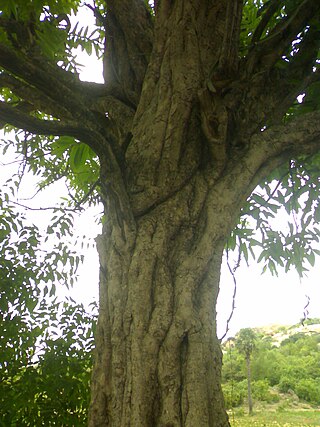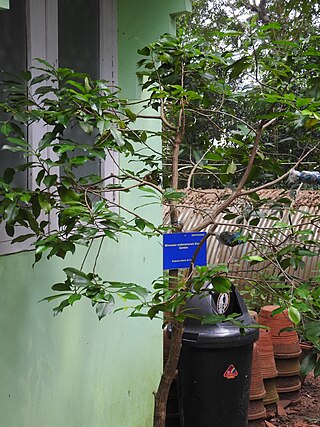
Manilkara bidentata is a species of Manilkara native to a large area of northern South America, Central America and the Caribbean. Common names include bulletwood, balatá, ausubo, massaranduba, quinilla, and (ambiguously) "cow-tree".

The Sapotaceae are a family of flowering plants belonging to the order Ericales. The family includes about 800 species of evergreen trees and shrubs in around 65 genera. Their distribution is pantropical.

Manilkara is a genus of trees in the family Sapotaceae. They are widespread in tropical and semitropical locations, in Africa, Madagascar, Asia, Australia, and Latin America, as well as various islands in the Pacific and in the Caribbean. A close relative is the genus Pouteria.

Manilkara zapota, commonly known as sapodilla, sapote, chicozapote, chicoo, chicle, naseberry, nispero, or soapapple, among other names, is an evergreen tree native to southern Mexico and Central America. An example natural occurrence is in coastal Yucatán, in the Petenes mangroves ecoregion, where it is a subdominant plant species. It was introduced to the Philippines during Spanish colonization. It is grown in large quantities in Mexico and in tropical Asia, including India, Pakistan, Thailand, Malaysia, Cambodia, Indonesia, Vietnam, Bangladesh, as well as in the Caribbean.
Manilkara elata, also called the cow tree, is a species of plant in the family Sapotaceae. It is Endemic to the Amazon region in Brazil, where it is endangered by habitat loss.
Manilkara excelsa is a species of plant in the family Sapotaceae. It is endemic to Brazil, and threatened by habitat loss.
Manilkara excisa is an endangered species of tall tree in the sapodilla family. It is endemic to the extremely steep, forested limestone hills of Trelawny, Cockpit Country and St. James parishes in Jamaica, where, although it is highly prized for its wood, it is threatened by habitat loss.
Manilkara gonavensis is a tree species in the sapodilla family endemic to Haiti's Gonâve Island that is considered to be possibly extinct.

Manilkara longifolia, commonly known as masseranduba, is a species of plant in the family Sapotaceae. It is endemic to Brazil, where it is threatened by habitat loss.
Manilkara paraensis is a species of plant in the family Sapotaceae. It is endemic to Brazil, where it is threatened by habitat loss.
Manilkara pleeana, the zapote de costa, is a species of plant in the family Sapotaceae. It is endemic to Puerto Rico.
Manilkara rufula is a species of tree in the Sapodilla family. It is endemic to the northeastern submontane forests of Bahia, Sergipe, Pernambuco, Paraíba, Ceará and Piauí states of Brazil. Although this species exists in many places, where it occurs it is either not numerous, or its numbers are declining due to loss of habitat.
Manilkara spectabilis is an uncommon species of tree in the sapodilla family.
Manilkara subsericea is a species of plant in the family Sapotaceae. It is endemic to Brazil, and threatened by habitat loss.
Manilkara valenzuelana is a species of tree or tall shrub in the Sapodilla family. It is found in coastal and subcoastal semi-deciduous forests of Cuba, the Dominican Republic, Haiti, and possibly Puerto Rico. Its habitat has been declining rapidly under pressure from charcoal makers, logging, and the clearing of forest for human habitation.

Mimusops is a genus of plants in the family Sapotaceae described as a genus by Linnaeus in 1753.

Barringtonia asiatica is a species of Barringtonia native to mangrove habitats from islands of the Indian Ocean in the west to tropical Asia and islands of the western Pacific Ocean. It is grown along streets for decorative and shade purposes in some parts of India, for instance in some towns on the southeastern shore. It is also known as Box Fruit due to the distinct box-shaped fruit it produces. The local name futu is the source of the name for the Polynesian island Futuna. The type specimen was collected by botanist Pehr Osbeck on a sandy beach area on the island of Java, later to be described by Carl Linnaeus in his Species Plantarum in 1753.

Manilkara hexandra is a tree species in the tribe Sapoteae, in the family Sapotaceae. It is native to much of the Indian subcontinent: Bangladesh, India, and Sri Lanka; Indo-China: Cambodia, Myanmar, Thailand and Vietnam. Its vernacular names vary regionally; for example "Palu", "Palai"(பாலை) in Tamil or "Rayan" (පලු) in Sinhalese. It is locally known as the Khirni tree in parts of Bangladesh and India. In the Tamil language it is called Ulakkaippaalai or Kanuppaalai.

Manilkara huberi, also known as masaranduba, níspero, and sapotilla, is a fruit bearing plant of the genus Manilkara of the family Sapotaceae.

Mimusops andamanensis is a species of plant in the family Sapotaceae. It is native to Sri Lanka and the Andaman Islands.











